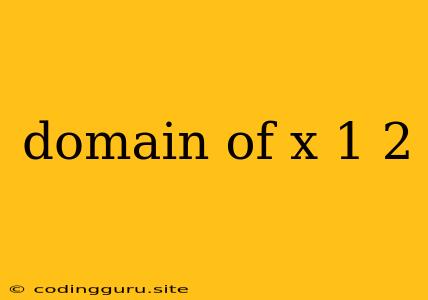Understanding the Domain of a Function: A Guide to 'x' Values
In the realm of mathematics, particularly within the study of functions, the term "domain" holds significant importance. It essentially defines the set of all possible input values, often represented by the variable 'x', for which a function can produce a valid output.
Let's delve into the concept of domain with a focus on understanding how it relates to 'x' and the numbers 1 and 2.
What is the Domain of a Function?
Imagine a function like a machine that takes an input, processes it, and gives you an output. The domain is simply the set of all possible inputs the machine can accept without causing any errors or undefined results.
For instance, if a function is defined as f(x) = x^2, the domain encompasses all real numbers. This is because you can square any real number without encountering any problems.
Why is the Domain Important?
Understanding the domain of a function is crucial for several reasons:
- Avoiding Errors: Knowing the domain prevents you from plugging in values that would lead to undefined results, such as dividing by zero or taking the square root of a negative number.
- Interpreting the Function's Behavior: The domain helps you understand the function's limitations and how it behaves across different input values.
- Solving Equations: When solving equations involving a function, you need to consider its domain to ensure that the solutions you find are valid.
The Role of 'x' in the Domain
The variable 'x' often represents the input to a function. In defining the domain, we are essentially asking: "What values of 'x' can we plug into the function without causing any problems?"
The Numbers 1 and 2 in Domain Context
Let's see how the numbers 1 and 2 might relate to the domain of a function:
- Restrictions: If a function has a specific restriction, such as not allowing 'x' to be equal to 1 or 2, then these numbers would be excluded from the domain. This could be due to a denominator becoming zero or a square root becoming negative.
- Specific Points: 1 and 2 could represent specific points within the domain. For example, if the domain is all real numbers, then both 1 and 2 would be valid inputs for the function.
Examples:
Example 1:
Consider the function f(x) = 1/(x-1).
- Domain: The domain of this function is all real numbers except for x = 1. This is because when x = 1, the denominator becomes zero, resulting in an undefined value.
Example 2:
Consider the function f(x) = √(x-2).
- Domain: The domain of this function is all real numbers greater than or equal to 2. This is because the square root of a negative number is undefined.
Conclusion
The domain of a function defines the set of all possible input values, represented by 'x', for which the function can produce a valid output. Understanding the domain helps you avoid errors, interpret the function's behavior, and solve equations correctly. The numbers 1 and 2 might be included or excluded from the domain depending on the specific function and its restrictions. By understanding the domain of a function, you gain a deeper understanding of its characteristics and limitations.
